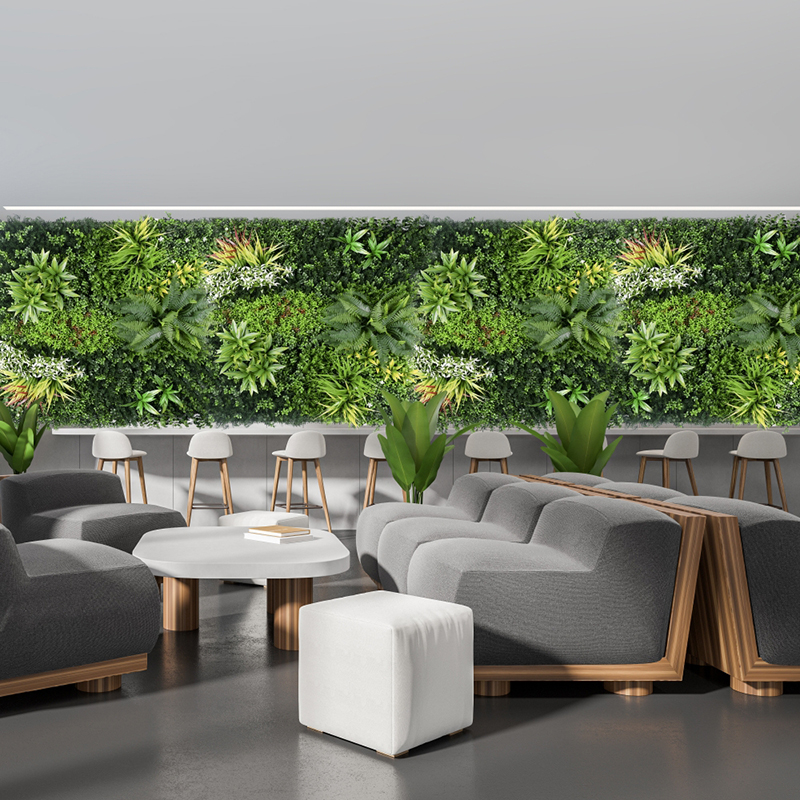Key Considerations for Accessible Design in 3D Artificial Vertical Gardens
Creating inclusive 3D artificial vertical gardens requires thoughtful planning to ensure they are usable and enjoyable for people of all abilities. These installations, often found in public spaces, museums, or corporate settings, must balance aesthetic appeal with functional accessibility. By addressing physical, sensory, and cognitive needs, designers can craft environments that foster engagement without compromising on innovation. Below are essential principles to guide accessible design in these dynamic structures.

Universal Physical Accessibility
Ensuring that 3D artificial vertical gardens are physically accessible begins with strategic placement and layout. The installation should be positioned along clear, wide pathways that accommodate wheelchairs, strollers, and mobility aids. Avoiding abrupt changes in elevation or narrow corridors prevents barriers for users with limited mobility. Additionally, incorporating ramps or gently sloping surfaces instead of stairs ensures seamless navigation between different levels of the garden, if applicable.
Tactile elements play a crucial role in making these gardens navigable for individuals with visual impairments. Adding raised textures, Braille labels, or 3D-printed models of plant designs allows users to explore the installation through touch. These features should be placed at consistent heights and accompanied by audio descriptions via smartphones or dedicated devices to provide context about the displayed elements.
Proximity to seating areas is another critical factor. Providing sturdy benches or resting spots nearby enables users who tire easily to enjoy the garden comfortably. These seating options should be positioned to offer optimal views of interactive or visually striking components while maintaining enough space for easy maneuvering.
Sensory-Inclusive Design Strategies
3D artificial vertical gardens often rely on visual and auditory stimuli, which can pose challenges for individuals with sensory sensitivities. To address this, designers should offer adjustable lighting options, such as dimmable LEDs or shaded areas, to accommodate those prone to overstimulation. Similarly, incorporating quiet zones or sound-absorbing materials near interactive features ensures that users with auditory processing differences can engage without discomfort.
For users with hearing impairments, visual alternatives to audio cues are essential. Subtitles or captions for any narrative content, such as guided tours or educational videos, should be displayed prominently. Flashing lights or vibrating alerts can also replace sound-based notifications in interactive components, ensuring that information is conveyed through multiple channels.
Color contrast and clarity are vital for users with low vision. High-contrast designs, such as dark text on light backgrounds or vice versa, improve readability of labels and instructions. Avoiding overly complex patterns or glare-prone materials in the garden’s structure further enhances visibility, making it easier for everyone to appreciate the details.
Cognitive and Learning Accessibility
Simplifying navigation and interaction is key to creating cognitive-friendly 3D artificial vertical gardens. Clear signage with universally recognized symbols, such as arrows or icons, helps users understand the layout and locate specific features without confusion. Interactive elements should be intuitive, requiring minimal instruction—for example, touch-sensitive panels with immediate feedback or motion-activated displays that respond predictably to movement.
Offering multiple ways to engage with the garden supports diverse learning styles. Some users may prefer hands-on exploration, while others might benefit from audio guides or downloadable resources that explain the design concepts in detail. Providing materials in various formats, such as print, digital, or large-print versions, ensures that information is accessible regardless of individual preferences or needs.
Consistency in design elements reduces cognitive load. Repeating patterns, colors, or interactive mechanisms throughout the installation helps users build familiarity, making it easier to navigate larger or more complex gardens. Additionally, avoiding sudden changes in functionality—such as switching between touch-based and voice-activated controls without warning—prevents frustration and encourages prolonged engagement.
Technology Integration for Enhanced Accessibility
Leveraging technology can significantly improve accessibility in 3D artificial vertical gardens. Mobile apps compatible with screen readers or voice assistants allow users with visual impairments to access detailed information about the installation independently. These apps can also offer customizable experiences, such as adjusting font sizes or contrast settings to suit individual needs.
Augmented reality (AR) features can provide immersive, hands-free exploration for users with physical disabilities. By scanning the garden with a smartphone or tablet, visitors can unlock layers of content, such as 3D models of plants or historical context, without needing to touch physical components. This technology also benefits users who may have difficulty reaching higher sections of the garden, as it brings the experience to their eye level.
Ensuring that all technological features are compatible with assistive devices is non-negotiable. For instance, interactive kiosks should support keyboard navigation and be positioned at heights accessible to wheelchair users. Regular testing with diverse user groups helps identify and resolve potential barriers, ensuring that technology enhances rather than hinders accessibility.
Collaboration with Diverse User Groups
The most effective accessible designs emerge from collaboration with the communities they serve. Engaging individuals with disabilities, seniors, and caregivers throughout the planning process ensures that their perspectives shape every decision. User testing sessions can reveal unforeseen challenges, such as the need for additional resting areas or clearer instructions, allowing designers to refine the installation before completion.
Incorporating feedback loops post-installation is equally important. Gathering input from visitors through surveys or focus groups helps identify areas for improvement and demonstrates a commitment to ongoing inclusivity. This iterative approach not only enhances the garden’s accessibility but also fosters a sense of ownership among users, making them feel valued and heard.
By prioritizing universal design principles, 3D artificial vertical gardens can become spaces where everyone—regardless of ability—can connect with nature, art, and technology. These installations then transcend their role as decorative features, evolving into symbols of equity and innovation in urban environments.
Contact: Amy
Phone: 86-15311787313
E-mail: info@foszmac.com
Whatsapp:86-15311787313
Add: Fengtai District, Dacheng Road, No.24 Building, Room 203, Beijing, China